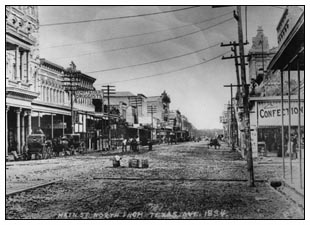OUR LEGACY
 From the banks of a bayou to men on the moon, Houston's history spans 178 years of growth and development. From its simple beginning as 6,642 acres of land on the banks of Buffalo Bayou, Houston has grown to become the fourth largest U. S. city encompassing 581 square miles with more than 1.6 million people.
From the banks of a bayou to men on the moon, Houston's history spans 178 years of growth and development. From its simple beginning as 6,642 acres of land on the banks of Buffalo Bayou, Houston has grown to become the fourth largest U. S. city encompassing 581 square miles with more than 1.6 million people.
Since the early nineteenth century Houston has undergone dramatic transformation. Its development goals were first set in 1836 by it founders, Augustus and John Allen, and from then on Houston pursued its great course throughout the nineteenth century and into the twenty-first century with such tenacious determination that any obstacles proved transitory.
For centuries before Europeans arrived in the area, numerous nomadic Indian tribes—the Bidais, Karankawas and Arkokisas (Orcoquisacs)—sparsely inhabited the territory.
The Bidais left few lasting impressions of their culture. The Karankawas, who lived to the southeast near Galveston Coast, are remembered for their harassment of early settlers, among whom was the notorious eighteenth century French pirate Jean Laffite. The seminomadic, rather primitive Orcoquisacs lived in the aftermath of the agricultural based civilization of the mound-building East Texas Caddo tribe. The Caddo word for "friendly," tejas, gave the state its name. The Orcoquisacs were a small tribe which roamed the lower San Jacinto and Trinity river valleys, fishing in family groups along the upper reaches of Galveston Bay. In winter time they settled into semi permanent villages along Spring Creek, in the northern part of present-day-Harris County. There , the Orcoquisacs hunted bear, deer and buffalo, and sometimes cultivated maize.
The Indians made an outstanding contribution to local lore and folkways. Among their tales none is more fanciful than that of the origin of the cannibal " Fish-Eaters." The first Karankawa, so the legend goes, was the child of the sun god and moon goddess, and his cradle an oyster shell that rocked gently upon a cloud. One day while his parents quarreled the cradle was knocked from the sky and fell into the Gulf of Mexico; the tears of the goddess account for invariably abundant rainfall along the coast. Karankawas revered the oyster.
Jean Laffite's occupation of Galveston Island and his journeys up the nearby streams gave rise to much treasure lore. As late as 1912 a chest containing old Spanish coins, believed to have been cached by pirates, was unearthed by fishermen after W. D. Warren had found a crested silver cruet at the mouth of the San Bernard. Legends have persisted of gold buried by Spaniards and Mexicans, and so diligent have been the searchers that Dead Man's Lake has twice been drained and excavated: first by Dr. W.F. Dearen, and in 1930 by the Sullivan brothers of Houston. A story that the gold of General Santa Anna lies buried somewhere in the marshes of the San Bernard has inspired many a futile search; yet in 1929 a pot of gold estimated to contain $2,000 was dug up at the corner of Houston and Washington Avenues where a filling station was being erected. That discovery brought forth almost forgotten tales. Great holes yawing along the shores where the San Jacinto River enters into Galveston Bay, where pirate ships, once anchored, and others along the routes followed by Spanish and Mexican caravans, indicate the perennial labors of treasure hunters.






